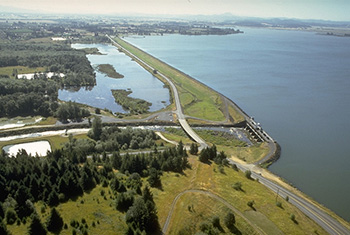Eel Lake, OR
Eel Lake is a large, deep lake in a chain of water bodies along the Oregon Coast. The area is a popular destination for camping, picnicking, boating, kayaking, fishing, and swimming.
SIZE --- Eel Lake covers 355 acres and is an outstanding location for water activities where you can enjoy swimming, fishing, boating, paddle boarding, tubing, and canoeing. It has an average depth of 35 feet with the deepest part being approximately 65 foot in depth. (Very family friendly.)
LOCATION --- Approximately 3 miles from Lakeside, Oregon
SPECIES OF FISH --- Fish species include native cutthroat trout, coho salmon, steelhead, and rainbow trout; and non-native largemouth bass, yellow perch, and bluegill.
FISHING REPORT - The Regional Best Bets For Fishing by the Oregon Department of Fish and Wildlife. Largemouth and smallmouth bass are in Eel Lake, and angler reports back that up.
CAMPING - William M. Tugman State Park is located at the on the western arm of Eel Lake.
BAIT AND TACKLE - Lakeside Marina
TIPS On BASS Fishing - "Basic Tips" Catching largemouth bass in Eel Lake, Oregon, can be an enjoyable and rewarding experience. Here are some tips to help you increase your chances of success:
Research the Lake:
Study maps of Eel Lake to identify potential bass hotspots, such as submerged structures, weed beds, and points. Look for local fishing reports or consult with local anglers to get updated information about the lake's bass population and recent catches. Choose the Right Gear:
Use medium-heavy to heavy fishing rods, typically between 6-7.5 feet in length, paired with a baitcasting reel or spinning reel with a strong drag system. Use braided or fluorocarbon fishing line, usually in the 12-20-pound test range, depending on the cover and size of bass you're targeting. Select the Right Lures and Baits:
Largemouth bass in Eel Lake can be enticed with a variety of lures, such as soft plastics, crankbaits, jigs, spinnerbaits, and topwater lures. Experiment with different colors and sizes to match the local forage and water conditions. Fish During the Right Seasons:
Spring and fall are typically the best times to target largemouth bass when they are more active and feeding. During the summer, bass may be deeper and less active, so adjust your fishing techniques accordingly. Target Ideal Spots:
Focus on areas with underwater structure like fallen trees, rocks, submerged vegetation, and boat docks where bass often hide and ambush prey. Pay attention to points, coves, and the edges of weed beds, as these can be productive spots. Work Your Lures Slowly:
Largemouth bass are often attracted to slow-moving or suspended baits. Try using a slow, erratic retrieve to mimic injured prey. When using soft plastics or jigs, give them a subtle, lifelike action by gently lifting and dropping your rod tip. Be Patient and Persistent:
Bass fishing can be a game of patience. Don't get discouraged if you don't get immediate results. Keep trying different lures and techniques until you find what works on a particular day. Practice Catch and Release:
Consider practicing catch and release to help maintain a healthy bass population in Eel Lake. Check local regulations for size and bag limits and follow them accordingly. Stay Informed:
Stay up to date with local fishing regulations and be aware of any changes or restrictions. Join local fishing forums or clubs to stay connected with other anglers who can provide valuable insights. Remember that fishing can vary based on the season, weather, and other environmental factors. Be adaptable and willing to change your approach based on the conditions you encounter on the day of your fishing trip.
